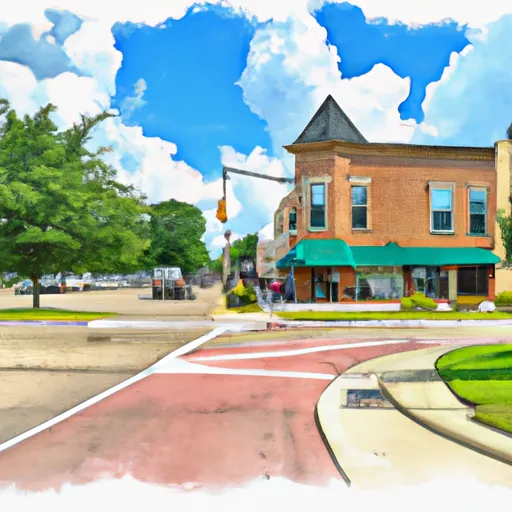-
 Snoflo Premium
Snoflo Premium
Get unlimited access to all our content
With no Ad interruptions! - Start Your Free Trial Login with existing account
Milan
Eden Index
Climate
7.7
•
Recreation
4.5
•
Community
3.4
•
Safeguard
5.5/10

Milan, Michigan is a small town located in Washtenaw County, in the southeastern part of the state. With a population of around 5,900 residents, Milan offers a charming and peaceful atmosphere.
The climate in Milan is classified as humid continental, experiencing warm summers and cold winters. Average temperatures range from the mid-20s°F (-4°C) in winter to the low 80s°F (27°C) in summer. Precipitation is relatively evenly distributed throughout the year, with rain being the dominant form.
The hydrology constituents in Milan are defined by the Saline River, which flows through the town. The river not only adds to the aesthetic beauty of the area but also provides opportunities for fishing and boating enthusiasts.
Outdoor recreation opportunities in Milan are abundant. The town has several parks, including Wilson Park and Symons Recreation Complex, offering facilities for picnicking, sports, and nature walks. Additionally, Milan hosts the Milan Dragway, where visitors can enjoy watching thrilling drag racing events. The surrounding countryside also provides opportunities for hiking, biking, and birdwatching.
With its pleasant climate, scenic river, and diverse outdoor activities, Milan, Michigan offers a peaceful and enjoyable environment for residents and visitors alike.
What is the Eden Index?
The Snoflo Eden Index serves as a comprehensive rating system for regions, evaluating their desirability through a holistic assessment of climate health, outdoor recreation opportunities, and natural disaster risk, acknowledging the profound impact of these factors on livability and well-being.
Climate Health Indicator (CHI): 7.7
Milan receives approximately
889mm of rain per year,
with humidity levels near 80%
and air temperatures averaging around
10°C.
Milan has a plant hardyness factor of
6, meaning
plants and agriculture in this region thrive during a short period during spring and early summer. Most
plants will die off during the colder winter months.
By considering the ideal temperature range, reliable water supplies, clean air, and stable seasonal rain or snowpacks, the Climate Health Indicator (CHI) underscores the significance of a healthy climate as the foundation for quality living.
A healthy climate is paramount for ensuring a high quality of life and livability in a region, fostering both physical well-being and environmental harmony. This can be characterized by ideal temperatures, reliable access to water supplies, clean air, and consistent seasonal rain or snowpacks.
Weather Forecast
Streamflow Conditions
Western Lake Erie
Area Rivers
Western Lake Erie
Snowpack Depths
Western Lake Erie
Reservoir Storage Capacity
Western Lake Erie
Groundwater Levels
Recreational Opportunity Index (ROI): 4.5
The Recreational Opportunity Index (ROI) recognizes the value of outdoor recreational options, such as parks, hiking trails, camping sites, and fishing spots, while acknowledging that climate plays a pivotal role in ensuring the comfort and consistency of these experiences.
Access to outdoor recreational opportunities, encompassing activities such as parks, hiking, camping, and fishing, is crucial for overall well-being, and the climate plays a pivotal role in enabling and enhancing these experiences, ensuring that individuals can engage in nature-based activities comfortably and consistently.
Camping Areas
| Campground | Campsites | Reservations | Toilets | Showers | Elevation |
|---|---|---|---|---|---|
| Murray Lake - Brighton Rec Area | None | 875 ft | |||
| Camp Dearborn | 191 | 934 ft | |||
| Proud Lake State Rec Area | 130 | 1,002 ft | |||
| Groveland Oaks County Park | None | 963 ft | |||
| Wayne County Fairgrounds RV | None | 691 ft | |||
| Bishop Lake - Brighton Rec Area | None | 901 ft | |||
| Mary Jane Thurston State Park | 35 | 644 ft | |||
| Highland State Rec Area | 40 | 977 ft | |||
| Appleton Lake - Brighton Rec Area | None | 888 ft | |||
| Pontiac Lake State Rec Area | 175 | 1,015 ft |
Nearby Ski Areas
Catastrophe Safeguard Index (CSI):
The Catastrophe Safeguard Index (CSI) recognizes that natural disaster risk, encompassing floods, fires, hurricanes, and tornadoes, can drastically affect safety and the overall appeal of an area.
The level of natural disaster risk in a region significantly affects safety and the overall livability, with climate change amplifying these risks by potentially increasing the frequency and intensity of events like floods, fires, hurricanes, and tornadoes, thereby posing substantial challenges to community resilience and well-being.
Community Resilience Indicator (CRI): 3.4
The Community Resilience Indicator (CRI) recognizes that education, healthcare, and socioeconomics are crucial to the well-being of a region. The CRI acknowledges the profound impact of these elements on residents' overall quality of life. By evaluating educational resources, healthcare accessibility, and economic inclusivity, the index captures the essential aspects that contribute to a thriving community, fostering resident satisfaction, equity, and social cohesion.

